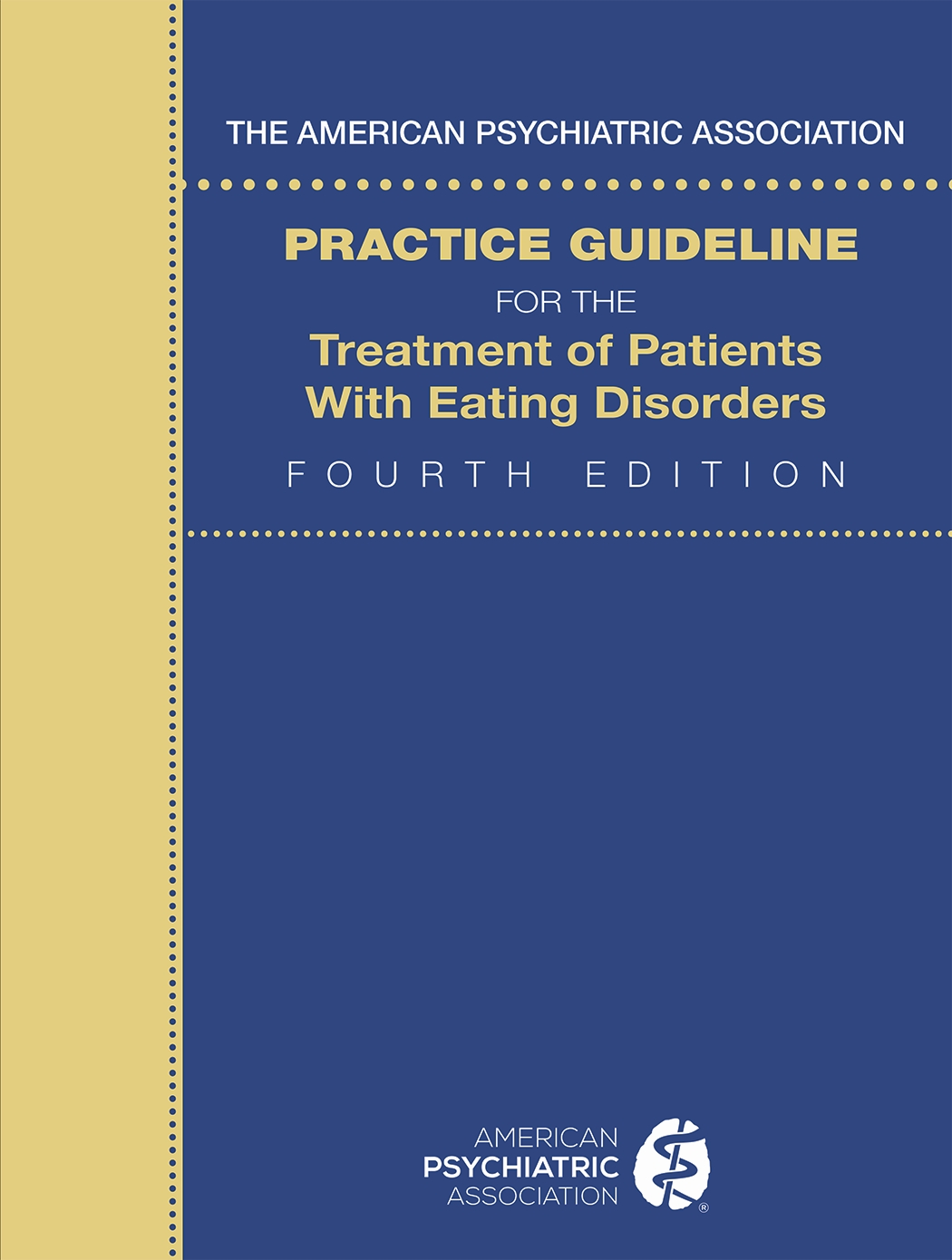Guideline Statement Summary
Assessment and Determination of Treatment Plan
-
APA recommends (1C) screening for the presence of an eating disorder as part of an initial psychiatric evaluation.
-
APA recommends (1C) that the initial evaluation of a patient with a possible eating disorder include assessment of
-
the patient’s height and weight history (e.g., maximum and minimum weight, recent weight changes);
-
presence of, patterns in, and changes in restrictive eating, food avoidance, binge eating, and other eating-related behaviors (e.g., rumination, regurgitation, chewing and spitting);
-
patterns and changes in food repertoire (e.g., breadth of food variety, narrowing or elimination of food groups);
-
presence of, patterns in, and changes in compensatory and other weight control behaviors, including dietary restriction, compulsive or driven exercise, purging behaviors (e.g., laxative use, self-induced vomiting), and use of medication to manipulate weight;
-
percentage of time preoccupied with food, weight, and body shape;
-
prior treatment and response to treatment for an eating disorder;
-
psychosocial impairment secondary to eating or body image concerns or behaviors; and
-
family history of eating disorders, other psychiatric illnesses, and other medical conditions (e.g., obesity, inflammatory bowel disease, diabetes mellitus).
-
-
APA recommends (1C) that the initial psychiatric evaluation of a patient with a possible eating disorder include weighing the patient and quantifying eating and weight control behaviors (e.g., frequency, intensity, or time spent on dietary restriction, binge eating, purging, exercise, and other compensatory behaviors).
-
APA recommends (1C) that the initial psychiatric evaluation of a patient with a possible eating disorder identify co-occurring health conditions, including co-occurring psychiatric disorders.
-
APA recommends (1C) that the initial psychiatric evaluation of a patient with a possible eating disorder include a comprehensive review of systems.
-
APA recommends (1C) that the initial physical examination of a patient with a possible eating disorder include assessment of vital signs, including temperature, resting heart rate, blood pressure, orthostatic pulse, and orthostatic blood pressure; height, weight, and body mass index (BMI; or percent median BMI, BMI percentile, or BMI Z-score for children and adolescents); and physical appearance, including signs of malnutrition or purging behaviors.
-
APA recommends (1C) that the laboratory assessment of a patient with a possible eating disorder include a complete blood count and a comprehensive metabolic panel, including electrolytes, liver enzymes, and renal function tests.
-
APA recommends (1C) that an electrocardiogram be done in patients with a restrictive eating disorder, patients with severe purging behavior, and patients who are taking medications that are known to prolong QTc intervals.
-
APA recommends (1C) that patients with an eating disorder have a documented, comprehensive, culturally appropriate, and person-centered treatment plan that incorporates medical, psychiatric, psychological, and nutritional expertise, commonly via a coordinated multidisciplinary team.
Anorexia Nervosa
-
APA recommends (1C) that patients with anorexia nervosa who require nutritional rehabilitation and weight restoration have individualized goals set for weekly weight gain and target weight.
-
APA recommends (1B) that adults with anorexia nervosa be treated with an eating disorder–focused psychotherapy, which should include normalizing eating and weight control behaviors, restoring weight, and addressing psychological aspects of the disorder (e.g., fear of weight gain, body image disturbance).
-
APA recommends (1B) that adolescents and emerging adults with anorexia nervosa who have an involved caregiver be treated with eating disorder–focused family-based treatment, which should include caregiver education aimed at normalizing eating and weight control behaviors and restoring weight.
Bulimia Nervosa
-
APA recommends (1C) that adults with bulimia nervosa be treated with eating disorder–focused cognitive-behavioral therapy and that a serotonin reuptake inhibitor (e.g., 60 mg fluoxetine daily) also be prescribed, either initially or if there is minimal or no response to psychotherapy alone by 6 weeks of treatment.
-
APA suggests (2C) that adolescents and emerging adults with bulimia nervosa who have an involved caregiver be treated with eating disorder–focused family-based treatment.
Binge-Eating Disorder
-
APA recommends (1C) that patients with binge-eating disorder be treated with eating disorder–focused cognitive-behavioral therapy or interpersonal therapy, in either individual or group formats.
-
APA suggests (2C) that adults with binge-eating disorder who prefer medication or have not responded to psychotherapy alone be treated with either an antidepressant medication or lisdexamfetamine.



